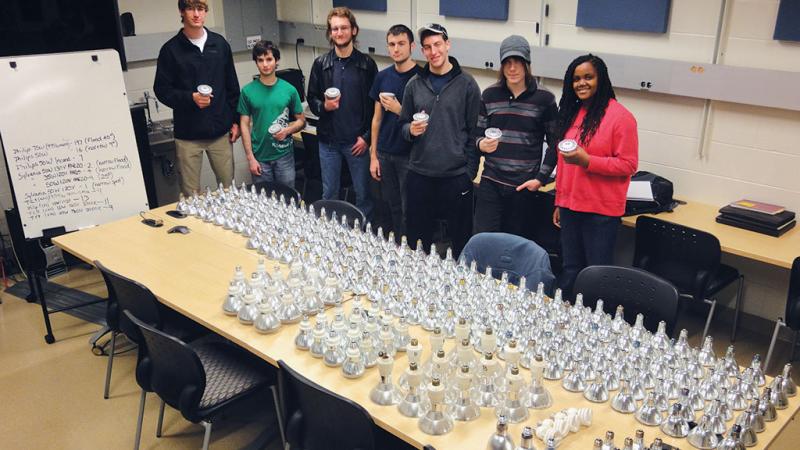Students at Rensselaer Polytechnic Institute Work With University Administration and Smart Lighting Engineering Research Center To Take first Step Toward Smarter, Better, and Less Expensive Lighting
December 12, 2012

An effort by students, faculty, and staff at Rensselaer Polytechnic Institute to install ultra-efficient LED light bulbs in one campus facility will save the university about $21,000 per year. Along with creating opportunities for reduced energy consumption and further cost savings in the future, the project is an important first step toward transforming the entire campus into a real-world laboratory for the emerging field of “Smart Lighting.”
Working closely with the Smart Lighting Engineering Research Center (ERC) and the Physical Plant office within the Division of Administration at Rensselaer, a group of undergraduate students researched and designed a plan to replace more than 300 halogen light bulbs in the Darrin Communications Center (DCC) with long-lived, energy-efficient LED bulbs. The LED bulbs use about 15 watts each and have a lifespan of more than five years, compared to the replaced 75-watt halogen bulbs with a lifespan of about four months. University staff installed the LED bulbs in the fall.
After the initial investment of $18,000 for the LED bulbs is recouped in 18 months, the Institute is expected to realize an estimated $21,000 per year in energy and labor costs savings as a result of the project. Additionally, the conversion to LEDs is expected to reduce the Institute’s annual carbon footprint by 123 metric tons of CO2, the equivalent to CO2 emissions from the consumption of 285 barrels of oil.
“About 30 percent of energy used in buildings goes to lighting, because most lighting technology is very inefficient,” said senior architecture major Dorothy Underwood, who helped lead the team of students working on the project. “So changing the lighting is low-hanging fruit when it comes to making buildings more energy-efficient.” Underwood worked with the Smart Lighting ERC through the Undergraduate Research Program at Rensselaer.
“This project has definitely raised my interest in lighting and technology, and has made me aware of how important lighting truly is,” said senior electrical engineering major Alex Dumitrescu, who worked closely with Underwood. “Now I enjoy telling my parents, family, and other students that LEDs can have an amazing impact on your energy bill, while making your home a bit more futuristic.”
Students from the O. T. Swanson Multidisciplinary Design Laboratory, as well as student volunteers, also contributed to the project. At the beginning of the project, the students tracked and analyzed the energy consumption and light quality of the original halogen light bulbs. They researched and identified potential replacement LED bulbs, calculated energy consumption and savings data, and ultimately selected bulbs from LED makers Sylvania and LEDnovation in order to optimize the lighting design in the DCC.
“The DCC bulb replacement project is a great example of how sustainability and strategic planning can have a positive impact on campus operations and result in significant cost savings,” said Physical Plant Director Ernie Katzwinkel. “It provided students with real-world experience in sustainability and incorporated Rensselaer infrastructure in research and academic endeavors.”
Looking forward, the Smart Lighting ERC and Division of Administration plan will build upon this project and design and install control systems that will allow more sophisticated manipulation and use of the LED bulbs. Additionally, students are investigating the best location on campus for the next major bulb replacement effort.
This bulb replacement is the first step toward the goal of realizing a campus-wide intelligent lighting system that can be used as test bed for leading-edge lighting technology, said Smart Lighting ERC Director Robert Karlicek. The center’s vision includes smart lighting systems that pair sophisticated sensor and control systems with high-performing LEDs that automatically adapt to provide the perfect light for any given situation to enhance human comfort, performance, and productivity. Other new features will include color control, light-based wireless access, and advanced energy savings through integration with building and power company control systems.
“The average American spends more than 90 percent of their time indoors, with almost constant exposure to lamps, lighting fixtures, computers, televisions, and other artificial light sources. We are only beginning to understand how lighting impacts our health, moods, concentration, and stress levels,” said Karlicek, professor in the Department of Electrical, Computer, and Systems Engineering at Rensselaer. “Research being done in the Smart Lighting ERC is creating lighting systems that think, and that always provide the best lighting with the least energy use.”
The Smart Lighting ERC was launched in 2008 and is funded primarily by the National Science Foundation. Led by Rensselaer, the Smart Lighting ERC core partners are Boston University and the University of New Mexico.